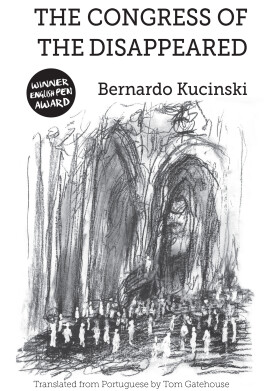The Congress of the Disappeared is the latest of writer and journalist Bernardo Kucinski’s many profoundly illuminating works denouncing the violence and murderous tendencies that have characterized the Brazilian state up to the present day. Translated into English by Tom Gatehouse, the book is essential reading for those seeking to understand how the cycle of impunity and deliberate attempts to erase collective memory have shaped the country’s current social and political fabric – a moment the author describes as an ‘outbreak of fascism’.
‘Literature gives voice to the vanquished’
The Congress of the Disappeared welcomes into the spotlight those forcibly disappeared and assassinated – not only during Brazil’s military dictatorship but throughout the nation’s history, since its very inception. These ghosts are the protagonists. In fact, they are the only characters who speak. In doing this, Kucinski weaves an alternative history teeming with spectres, where silence becomes deafening and the void left by countless vanished bodies begins to take shape.
In an essay reviewing Kucinski’s newest work, Marcelo Rubens Paiva – novelist and son of the disappeared ex-congressman and civil engineer Rubens Paiva, whose forced disappearance forms the plot of the Oscar-winning film I’m Still Here – writes that ‘literature gives voice to the vanquished. It finds the disappeared. It delivers them imagined justice.’ For Paiva, the writer must continually return to the past to carry out a form of forensic investigation, unearthing that which has been buried and restoring the gaps in collective consciousness.
Kucinski’s novella begins with an unnamed first-person narrator wandering around Praça da República in Rio de Janeiro’s centre, where he and his comrade Rodriguez had been ambushed by military forces four decades earlier. Much to his surprise, and perhaps guided by the ‘Fates’, as they soon come to realize, Rodriguez also finds himself in the same space. Both lost their lives fighting for democracy during the dictatorship and, tombless, are left wandering the earthly plane in perpetual limbo, neither resting among the dead nor able to join the living.
The present moment is characterized by ‘memorials without memory’, and the dead who were denied a proper burial are left to linger. In the face of this, these two men’s chance encounter in Praça da República is productive: they conceive of a congress of the disappeared, with the double aim of preventing the ‘permanent erasure’ of victims and also to forestall the new fascism, one which, as put by the ghosts, ‘would never have arisen had our killers been punished.’ The perpetrators of torture, murder, and disappearances have never been held accountable; in fact, the 1979 Lei da Anisita (Amnesty Law) granted impunity to the perpetrators of violence during the dictatorship.
At the congress, the ‘Brazil of the disappeared reveal[s] itself’:
 They came from all corners of the country. From the Northeast came the disappeared from the Peasant Leagues, from the North the young combatants from the Araguaia campaign, from the Southeast the comrades from National Liberation Action, and from the South the soldiers from the regiment who had joined the Popular Revolutionary Vanguard, as well as six from Onofre Pinto’s group who had been killed in Iguaçu National Park.
They came from all corners of the country. From the Northeast came the disappeared from the Peasant Leagues, from the North the young combatants from the Araguaia campaign, from the Southeast the comrades from National Liberation Action, and from the South the soldiers from the regiment who had joined the Popular Revolutionary Vanguard, as well as six from Onofre Pinto’s group who had been killed in Iguaçu National Park.
Also present at the congress are Tiradentes, leader of the Brazilian revolutionary movement against colonial rule; Zumbi dos Palmares, quilombo leader and pioneer of the anti-slavery struggle; and Guaraní leader Sepé Tiaraju. Alongside them are victims of more recent violence, including those who disappeared during the Brumadinho dam disaster and victims of landgrabbers and police violence.
The congress represents a Brazil that many have long tried to make invisible. Though many figures are icons of history, they also form a version of the past often forcibly erased from history books. They are a Brazil of martyrs, who together march toward the country’s seat of democracy, Praça dos Três Poderes.
A meeting point of past, present, and future: the times have changed, the names have changed, but this essence remains the same.
The book is a meeting point of past, present, and future: of a Brazil that cannot move forward without confronting its history, of a nation that ‘cannot be at peace knowing that so many of its children remain unburied,’ because ‘a society which forgets its disappeared is condemned to a future of more disappearances.’ This sentiment evokes the concept of Sankofa, derived from the Akan people of Ghana – the idea of retrieving knowledge from the past to guide the future. This retrieval operates on two levels in The Congress of the Disappeared: it urges us to remember the dead, to name and immortalize them, and to look to history to understand what went so wrong, so as to ensure that no one else is murdered at the hands of the state. Unfortunately, Brazil is not quite there yet.
The book’s pertinence today
The congress will make us active protagonists again. It’ll show that you can kill the rebels, but the rebel spirit doesn’t die.
The Congress of the Disappeared leaves the reader with a terrifying realization: that history does not stop repeating itself in Brazil. Its release in English could not be more timely, coming just under a month after Brazil’s former president and ex-military officer Jair Bolsonaro received a historic 27-year prison sentence for attempting a coup d’état following his defeat in the 2022 presidential election.
Even more striking is the contrast between the congress of the disappeared and the actions of Brazil’s Congress today. On 17 September, the lower house of Congress approved a bill known as PEC da Blindagem (Shielding Amendment), which would have prohibited the prosecution of parliamentarians without congressional authorization — effectively granting them a new layer of legal immunity and weakening anti-corruption efforts. The bill was later rejected by the Senate. The irony is that the same people who seek to erase the history of struggle and resistance end up recalling it through their actions which echo patterns of violence and repression we have seen many times throughout Brazil’s history.
What The Congress of the Disappeared ultimately shows us is that Brazil is a nation that has never truly reconciled with its past. Kucinski demonstrates that what we have now are ‘slaveowners reincarnated as businessmen, bounty hunters as bank managers, bloodthirsty despots as political demagogues.’ There has been no real shift; oppression has just taken on new names and faces. However, as long as the ghosts of Brazil remain in the national imaginary, there will be resistance to fascism. After all, ‘memory is like an imaginary tomb.’
Now more than ever, Brazilians are called to remember and to use the past as a reason to fight for the future.
Congress of the Disappeared is published by Practical Action. This review was first published on www.lab.org.uk



















